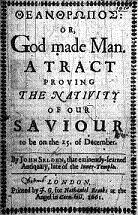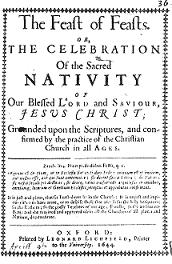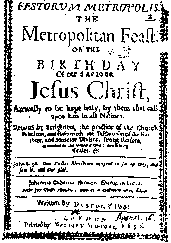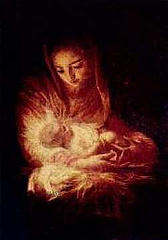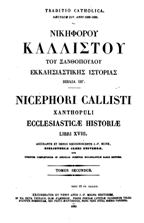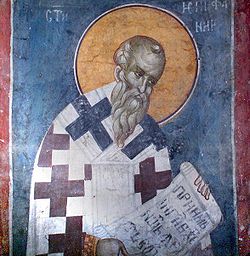Star of Bethlehem or Nazareth?
In this article we look at attempts to identify the star seen by the Magi in the east, and show that the star led them, not to Bethlehem, but to Nazareth forty-odd days after Christ’s birth.
Johannes Kepler
|
Attempts to identify the “star of Bethlehem” have come and gone down through the ages. Various phenomena and astrological occurrences have been proposed and served to corroborate the date of Christ’s birth. Among the earliest and longest standing attempts was that made by Johannes Kepler (1571-1630). |
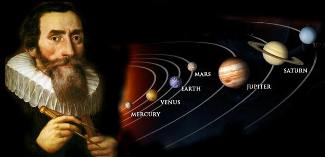 |
Kepler was one of the great mathematical minds of history. His works on the mathematical laws of planetary motion, showing that planets move in elliptical orbits, have stood the test of centuries and are still used by NASA and astronomers today.[1] Using his mathematical equations, Kepler believed he could predict the appearance of the night sky for any day in history, as seen from any place on earth. In 1604, Kepler witnessed a Jupiter-Saturn-conjunction, followed by a conjunction of Jupiter-Mars. Following the conjunction, Kepler witnessed that a new star as bright as Jupiter appeared, which he observed until it disappeared the following year into the sun’s glare. While writing a book about the observation,[2] Kepler came across a book by Laurence Suslyga of Poland that argued that Christ was born in 4 B.C. Noticing that this was after a triple conjunction in 7 B.C. and a massing of Mars, Jupiter, and Saturn in 6 B.C., Kepler speculated that just as a nova had appeared in 1604 after a series of junctions, the star of Bethlehem might have been a nova that was generated after the conjunctions in 7/6 B.C. Kepler wrote a book embodying his speculations.[3] No evidence that the conjunctions or massing of B.C. 6/7 produced a nova has ever been produced. Even so, Kepler’s speculations served as basis for the Christmas sky shows of planetariums world-wide for many years. However, sky shows featuring Kepler's speculations have now been replaced by the equally insupportable conjectures of Ernest L. Martin.
Ernest L. Martin
Dr. Ernest Martin (now disceased) was a world recognized authority concerning the date of Christ’s birth. Beginning with publication of his 1976 article in Christianity Today, “The Celestial Pageantry Dating Christ’s Birth,” Martin gained attention until he became perhaps the leading authority in astronomical dating of Christ’s birth. Over 600 planetariums world-wide revised their Christmas programs to correspond with dating theories and data he advanced. His book, “The Star that Astonished the World,” is considered the authoritative work on the date of Christ’s birth based upon astronomical events.[4]
 |
By reconstructing with computers the skies over ancient Jerusalem and the east as they may have looked 2,000 years ago, Martin believed “historians and astronomers may now be able to discover the very ‘star’ that led the Wise Men to the infant Jesus at Bethlehem.”[5] Indeed, Martin was convinced that the so-called star of Bethlehem has been identified. The astronomical events Martin believes account for the Star of the Magi occurred in the years 3/2 BC: |
1) May-Aug. 3 BC - A series of conjunctions between the planets Venus and Mars, Venus and Saturn, and Venus and Jupiter, the latter as a pre-dawn morning star configuration.
2) Sept. 3 BC – May 2 BC – A series of three conjunctions between the planet Jupiter and the star “Regulus.”
3) June 17, 2 BC – The conjunction of Jupiter and Venus as a “double star” in the constellation of Leo at the time of the full moon.
4) Aug. 27, 2 BC – The massing of Jupiter, Mars, Venus, and Mercury in close longitudinal relationship
5) Dec. 25, 2 BC – The “hesitation” of the planet Jupiter over Bethlehem in the course of its annual migration as it began its annual retrogression
Martin maintained that these celestial events would have been interpreted by astrologers and astronomers of the first century as indications of great world events, including the dawn of a new age and the birth of a new king. Martin urged that these celestial events drew the Magi to Jerusalem to do homage to the Christ-child, whom he maintained was born September 11, 3 B.C. There has been no shortage of astronomers willing to endorse Martin’s claims.[6] However, not only is there no evidence these events were actually witnessed or were interpreted as Martin claims, there are other major difficulties with Martin’s hypothesis.
Non-conformity with Gospel Record
First, the series of events described by Martin in no way conforms to the gospel narrative. The Magi were undoubtedly expert astronomers who probably came from the area of Chaldea; indeed, Martin affirms as much. Yet, Matthew is very clear that the Magi referred to the phenomenon that drew them to Jerusalem as a “star.” The Greek term Matthew employed is "aster" (singular). The term for multiple stars is the plural "asters," which no where occurs in the passage. The term for a group of planets or stars is “asteron” (Rev. 12:1). The Greek term for planet is "planes aster" and the plural is “planetes.” If the Magi saw a series of planetary conjunctions similar to those proposed by Martin, we would expect them to have used language reasonably calculated to communicating as much. The fact that they described a single star, and not a planet, or a series of conjunctions of stars or planets, argues against Martin’s suggestion. Indeed, it completely contradicts it. There is simply no justification for substituting Matthew's “star” for the series of conjunctions suggested by Martin.
Dating Tiberius’ Reign
Second, in order to make his theory fly, Martin is required to adopt a dating method for Roman emperors that includes the final year of thier predecessors (the "non-accession-year" system), making the 15th year of Tiberius A.D. 14 instead of A.D. 15. Luke is very explicit that Jesus was on the threshold of his 30th birthday when he was baptized in the 15th of Tiberius (Lk. 3:1, 21). Augustus died in A.D. 14. Thus, the 15th year of Tiberius’ reign would normallly be A.D. 29-30. But Martin changes this to A.D. 28-29. But Marin is wrong. The late Jack Finegan, a world leader in Biblical chronology, discusses the matter at length in his book and notes that Roman historians reckoned the reign of emperors from Jan. 1 to Dec. 31st, and concludes Luke would have done likewise:
|
“Now as for the date of the fifteenth year of Tiberius in Luke 3:1, we have judged that Luke, as a historian like others in the Roman empire, would count the regnal years from Tiberius’s succession to Augustus; and, since Roman historians of the time (Tacitus, Suetonius) generally date the first regnal year of a ruler from Jan 1 of the year following the date of accession (i.e., following the accession-year system), we judge that Luke would do likewise. So Tiberius’s fifteenth factual year was from Aug. 19, AD 28 to Aug. 18, AD 29, but his fifteenth regnal year counted as Julian calendar years according to the accession system was Jan. 1 to Dec. 31, AD 29.”[7] |
 |
All scholars and historians date regnal years as given by Finegan, above. Josephus dated Herod’s reign according to the prevailing Roman method.[8] If Josephus dated a Judean king’s reign by the western, Roman method, is it reasonable to argue that Luke dated a Roman emperor’s reign by what Martin alleges (but does not prove) was the Jewish method? Luke wrote to Greek and Latin speaking peoples of the larger Roman world. Who but Jews would know or anticipate something as obscure as Luke dating Tiberius’ reign by eastern customs? Surely, a historian would adopt a dating system known and anticipated by his intended audience. Anything else would only veil his work in mystery. Indeed, the only reason Martin attempts to date Tiberius’ reign as he does is that he is forced to it by his theory, which otherwise collapses upon itself. Finegan, based upon Thiele, reports that, with the exception of a short period from Jehoram to Joash, the accession-year system is what generally obtained in Judah.[9] Thus, Martin is virtually alone in reckoning Tiberius’ reign inclusive of A.D. 14. Hence, we are well advised not to follow him there. Instead, we adhere to the accepted method of reckoning, which makes the 15th of Tiberius equal A.D. 29-30. This means Jesus was born in 2 B.C. and turned 30 years old soon after his baptism, before Dec. 31st, A.D. 29.
Arrival of Magi
 |
Third, Martin places the Magi at Bethlehem Dec. 25th, 2 B.C., where they allegedly found the Christ-child, who has been there since September 11, 3 B.C., a period of not less than 15 months! This is contradicted by Luke, who reports that the holy family returned to Nazareth soon after Christ’s birth, having first gone to Jerusalem to accomplish the rituals required by the law: |
And when the days of her purification according to the law of Moses were accomplished, they brought him to Jerusalem, to present [him] to the Lord; (As it is written in the law of the Lord, Every male that openeth the womb shall be called holy to the Lord;) And to offer a sacrifice according to that which is said in the law of the Lord, A pair of turtledoves, or two young pigeons… And when they had performed all things according to the law of the Lord, they returned into Galilee, to their own city Nazareth. Lk. 2:22-39
Leviticus indicates that the period for a woman’s purification following birth of a male-child was 40 days (Lv. 12:1-8). Thus, the holy family remained at Bethlehem approximately 40 days, traveled five to ten miles to Jerusalem, performed the requirements of the law, then returned home to Nazareth. Thus, there is no basis for placing the holy family in Bethlehem December 25th, 2 B.C., unless that is when Christ was born (as indeed we believe he was). However, under Martin’s hypothesis, Jesus was born September 11, 3 B.C., and therefore could not have been there 15 months later when the Magi allegedly arrived.
Thus, Martin’s model is at odds with history and scripture at every turn and must be rejected. Indeed, we believe that all attempts to identify the Star of the Magi by reference to natural phenomena are doomed to failure, for Matthew’s narrative makes clear that the star was unlike anything in nature.
A Natural Phenomenon?
Attempts like Kepler’s and Martin’s to identify the star proceed upon the assumption that it was a regularly occurring and verifiable phenomenon of nature. However, we feel this is contradicted by Matthew’s narrative.
First, although Martin claims the star “astonished the world” and made ancient newspaper headlines, there is no evidence to support this. Just the opposite, so far as can be shown from scripture or history, nobody but the Magi witnessed the star. The annals of ancient history are completely silent about the appearance of a star that “astonished the world.” Matthew says that Magi arrived in Jerusalem asking “where is he that was born king of the Jews? For we have seen his star in the east, and are come to worship him” (Matt. 2:2). When report of the Magi reached Herod, they were secretly called before him (v.7). Herod then inquired when the star first appeared. We are not told the Magi’s response. However, since Herod ordered the slaughter of male children two and under “according to the time which he had diligently inquired of the wise men” (v. 16), we infer that the star was first seen some two years earlier. Based upon the gospel narrative, it is clear that neither Herod, his court, nor the Jews were so much as aware there was a star, otherwise they would not have to ask when it first appeared.
Second, unlike other stars or planets that are visible during the whole course of their movement across the sky, the star the Magi saw appeared at irregular intervals. In fact, so far as can be ascertained from scripture, it appeared first while they were still in the east (Matt. 2:2); disappeared, then reappeared two years later shortly after Jesus’ birth, to lead the Magi to the Christ-child. Matthew says that when the Magi departed from Herod “they saw the star," and “rejoiced with exceeding great joy" (v. 10). This indicates that there was a long period during which the star was not visible, and shows that it was not a normal phenomenon of nature. Stars do not normally vanish for up to two years, only to appear again suddenly at the very moment necessary to direct the Magi to the Christ-child. Rather, we believe the better view is that it was a divine apparition, and that God prophetically revealed to the Magi its meaning and significance, and directed them to make the pilgrimage to Jerusalem to see the Christ-child. The fact that God communicated with the Magi in a dream not to return to Herod (v. 12) tends to corroborate the view that the Magi did not journey to Jerusalem based upon human interpretation of heavenly signs, but that they received a divine revelation. How else could they know that it was king of the Jews that was born, as distinguished from all earth’s other peoples? God’s purpose in the star and pilgrimage of the Magi was to announce the birth of the Messiah. Were they mere astrologers or prognosticators whose interpretation of the star rested upon human wisdom, their arrival in Jerusalem would be greatly diminished. This was a very superstitious period in history and astrologers were constantly making predictions of political changes. But if the Magi received a divine revelation about the meaning of the star, then their appearance would indeed provoke great consternation among the Jews and the court of Herod. Other events God ordained to announce the coming and birth of the Messiah include the circumstances surrounding the birth of John the Baptist and the angelic proclamation to the Bethlehem shepherds.
When Did the Magi Arrive, and Where did the Star lead Them?
| As noted above, the holy family returned to Nazareth approximately 40 days after the birth of Christ. Did the Magi arrive while they were still in Bethlehem, or at Nazareth? Matthew states that when they found the young child, he was in a “house with his mother” (Matt. 2:11), not the manger where he had been born. This makes clear that the Magi were not present the night of Christ’s birth. Further, since they were in a house, not an inn, the natural inference is that the Magi found them at the family home. The term used by Matthew to describe Christ when the Magi arrived is “young child” (Gk. ton paidion) and is sometimes thought to suggest an older child as distinguished from a babe (Matt. 2:8, 9, 11, 13, 14, 19, 21). However, the same term is used by Luke of the babe the night of his birth (Lk. 2:17) and when eight days old at his circumcision (Lk. 2:21), and therefore does not imply he was two, or otherwise provide a reliable indication of his age when the Magi arrived. |
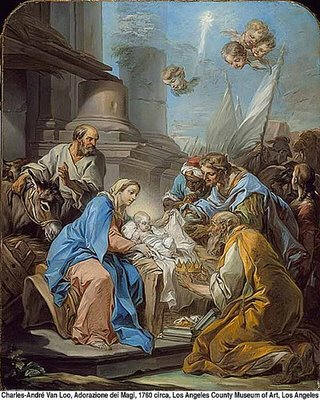 |
Matthew tells us that the holy family fled to Egypt immediately after the Magi departed and remained there until Herod’s death (Matt. 2:19). However, Luke’s narrative allows no room for flight to Egypt in the period between Christ’s birth and performing the necessary offerings at the temple some 40 days later. Based upon a Dec. 25th birth, this works out to February 2nd, 1, B.C. on the Julian calendar. Since the holy family returned home to Nazareth after performing the offerings, it seems clear that their flight to Egypt was from Nazareth, not Bethlehem and that it was here the Magi found them. This is why the star was necessary to reveal where Christ dwelt when the Magi arrived. Bethlehem is about five to ten miles south of Jerusalem. Herod, having learned from the scribes where Christ would be born, sent the Magi to Bethlehem to find him (Matt. 2:8). However, Matthew relates that the Magi, having departed from Herod, saw the star and that it “went before them till it came and stood over where the young child was” (Matt. 2:9). Since Herod had directed them to Bethlehem, the Magi plainly did not need the star to lead them there. Rather, the better view is that the star re-directed the Magi 70 miles north, to Nazareth, the holy family by this time having returned home.
The Magi appear to have traveled to and arrived at Nazareth by night, following the star (Matt. 2:9, 10). This would have helped conceal the arrival of the Magi and thus protect the holy family from discovery by Herod's tracing where the Magi went when they departed from Jerusalem. This is also why they were warned in a dream not to return to Herod, and thus returned home another way. However, Herod, perceiving he was mocked, sent and slew the male children in Bethlehem two years old and under (Matt. 2:16-18). Herod probably soon learned that the Magi never went to Bethlehem at all. Moreover, realizing that the Christ-child may not have remained in Bethlehem for two years in any event, Herod would likely have attempted to expand his search. The angel's warning that Herod would "seek the young child" (Matt. 2:13) confirms as much. Roman records of the census, which had been recently concluded if it was not still underway, would have recorded the presence of Joseph and Mary in Bethlehem and the birth of their child, and would have indicated that Nazareth was where they made their home. This required Joseph flee Herod's jurisdiction entirely, lest he find the babe. The holy family therefore fled to Egypt, where they remained until Herod's death. Herod most likely died sometime before Passover 1 B.C., following the Magi’s departure in early to mid February.
Conclusion
Martin's attempt to identify the Star of
Bethlehem
based upon natural phenomena contradicts both scripture and
history at many points and should be rejected. The better view
is that the Magi found the holy-child at Nazareth where Luke
informs us Joseph, Mary, and baby-Jesus returned 40-odds days
after his birth.
[1] They are: (1) All planets move about the Sun in elliptical orbits, having the Sun as one of the foci. (2) A radius vector joining any planet to the Sun sweeps out equal areas in equal lengths of time. (3) The squares of the sidereal periods (of revolution) of the planets are directly proportional to the cubes of their mean distances from the Sun.
[2] De Stella Nova in Pede Serpentarti, 1604, (Concerning a New Star in the Foot of the Serpent).
[3] De anno natali Christi, 1614. Cf., John Mosley, Common Errors in "Star of Bethlehem" Planetarium Shows, the Planetarian, Third Quarter 1981.
[4] ASK Publications, 1996
[5] Ibid, Introduction
[6] Craig Chester, President, Monterey Institute for Research in Astronomy, The Star of Bethlehem, IMPRIMIS (Hillsdale College) December 1993; John Mosley, Program Supervisor, Griffith Observatory, Common Errors in "Star of Bethlehem" Planetarium Shows, The Planetarian, Third Quarter 1981.
[7] Jack Finegan, Handbook of Biblical Chronology (Hendrickson, 1998 ed), p. 340 § 583.
[8] W. E. Filmer, The Chronology of Herod’s Reign, JTS 1966.
[9] Finegan, §§ 420, 421, pp. 245-248.
______________________________
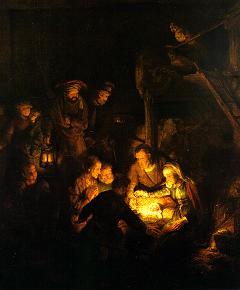
Adoration of the Shepherds
All rights reserved.
 John Seleden’s
John Seleden’s